So far on this blog we've looked at all those museums and memorials in Berlin, as well as the German Unity exhibits in neighboring Potsdam. Now, finally, we'll get to the actual experience of backpacking in Berlin on a four-day weekend.
Friday, September 4, 2020
Getting to Berlin from Stuttgart took about seven hours on two ICE trains, Stuttgart-Würzburg and Würzburg-Berlin. When I stepped off that last train, I was really hungry, so the first thing I had to do was eat lunch. Finding something to eat in Berlin's train station was even easier than in most others, because this massive facility felt less like a train station and more like an upscale multi-story shopping mall with rails running through it. I stopped at a restaurant called Dean & David and had a Salmon and Greens Express salad.
After lunch I stepped outside the station. Off in the distance I could see a dome and instantly knew what it was from all the pictures I've seen. It was a short walk to a point where I could get a good picture of it.
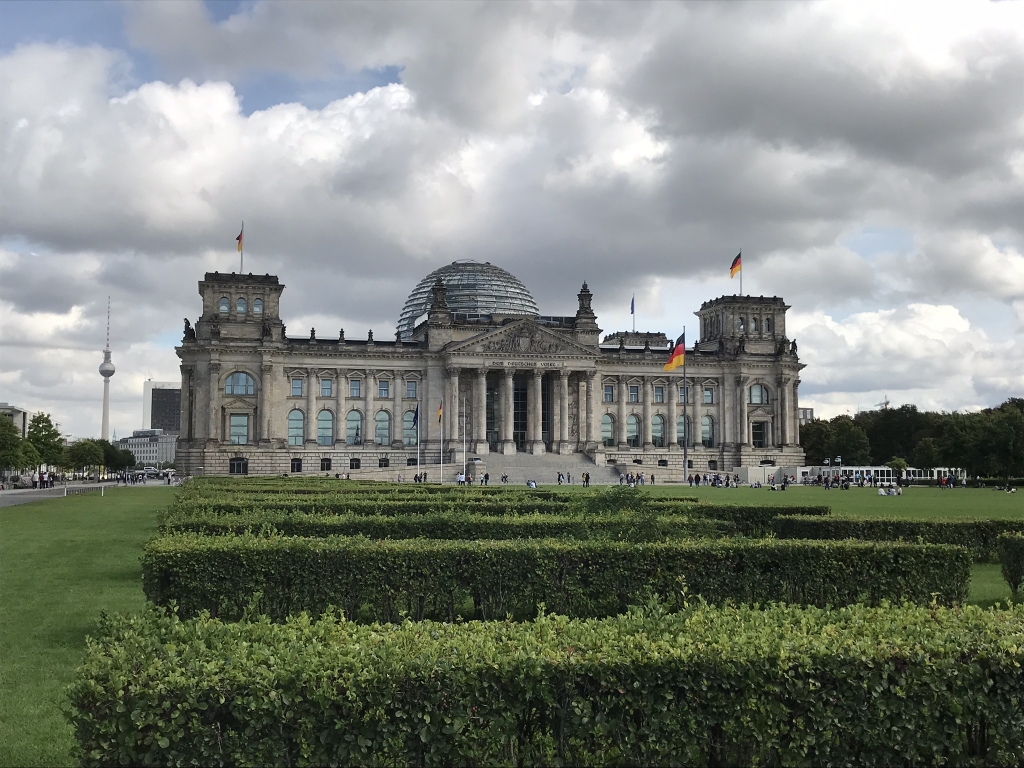
The Reichstag, one of Berlin's most famous buildings. It's the meeting hall of the Bundestag (Federal Assembly, lower house of the German Parliament). Built in 1894 for the Reichstag, lower house of the German Empire‘s parliament, subsequently used by Weimar Germany‘s Reichstag after WWI, it was severely damaged by the Reichstag Fire in 1933, in which Nazis set fire to the building, blamed it on Communists, and used this as an excuse to pass emergency laws that made then-Chancellor Hitler into a dictator. During the Cold War it went unused with a cursory restoration, with the Berlin Wall right next to it. After reunification, it got another restoration so it could host the Bundestag, which moved in from Bonn in 1999.
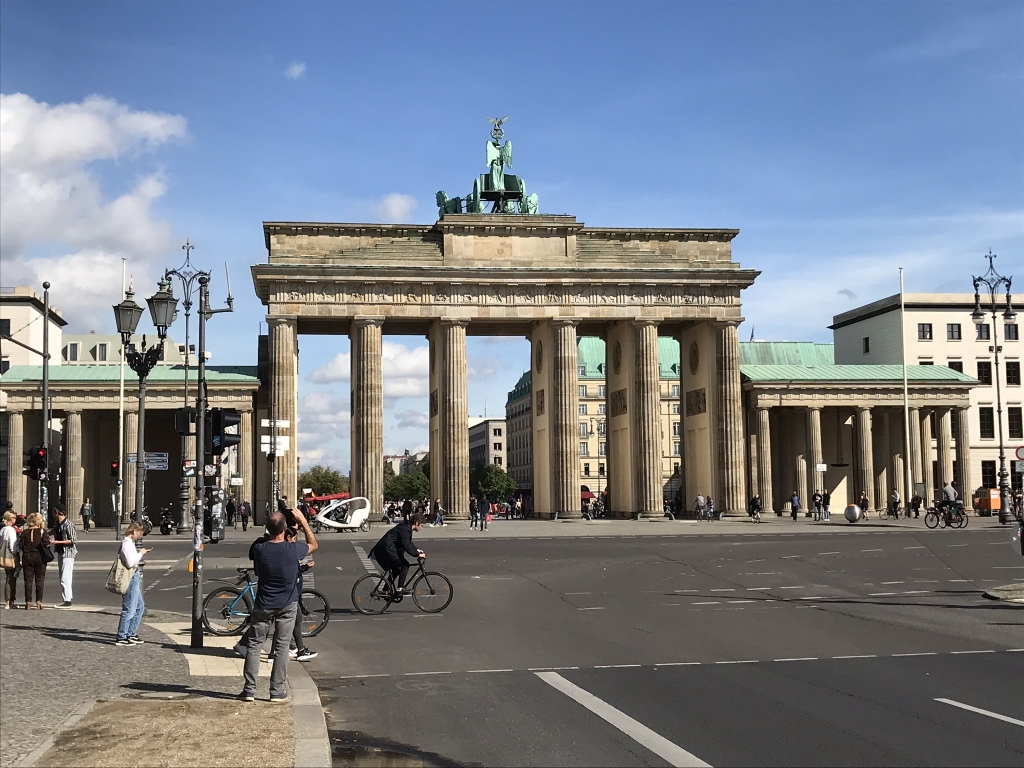
The Brandenburg Gate became a symbol of the Cold War thanks to its location. When the Berlin Wall was up, it was right in front of the gate, in between it and the spot where I'm standing here looking eastward. US Presidents Kennedy and Reagan delivered their "Ich bin ein Berliner" and "Tear Down This Wall" speeches with this in the background.
My next stop was something I'd wanted just to look at for years: Potsdamer Platz. Now this place has quite a history.
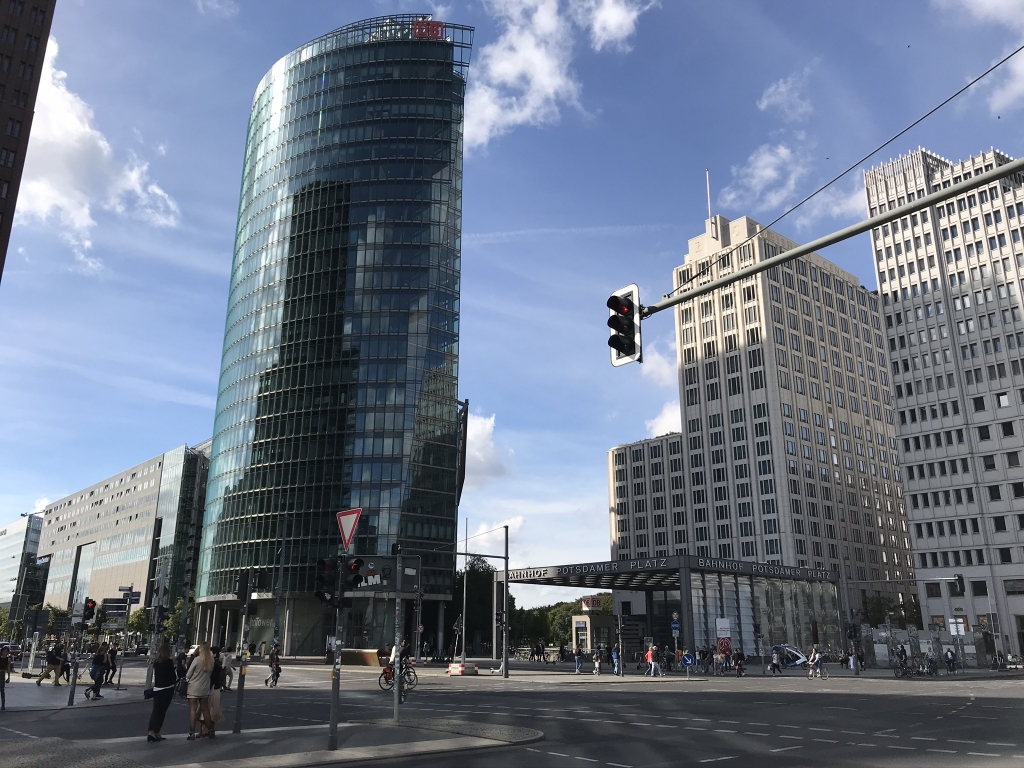
Before the Berlin Wall went up, especially before World War II, and most especially between the two World Wars, Berlin was a lively, happening city, and Potsdamer Platz was the center of the city's social life and nightlife at that time. Its real golden age was those eight wonderful years, roughly from 1925 to 1933, the time after Weimar Germany's economy stabilized but before the Nazis took over, the era depicted in the film "Cabaret."
World War II, of course, reduced most of the Platz to a pile of rubble. During the 1950s it slowly began to come back to life, until the construction of the Wall put a sudden end to it in 1961. The border between East and West Berlin ran right through Potsdamer Platz, and thus the wall cut right through the space. In fact, most of it wound up inside the infamous "death strip" in which any would-be escapees were shot on sight, so the whole square was abandoned overnight and left to decay, and stayed that way until the Wall came down.
As you can see, since 1990 it's been redeveloped out the wazoo. Today it's bustling with activity again, much like it was a century ago, with one crucial difference. Nearly everyone you find eating, drinking, and shopping in Potsdamer Platz today is a tourist, which makes it more like Times Square in New York City, the Las Vegas Strip, or the Riverwalk in San Antonio, Texas, where I used to live. So, it's not really the heart of the city like it used to be.
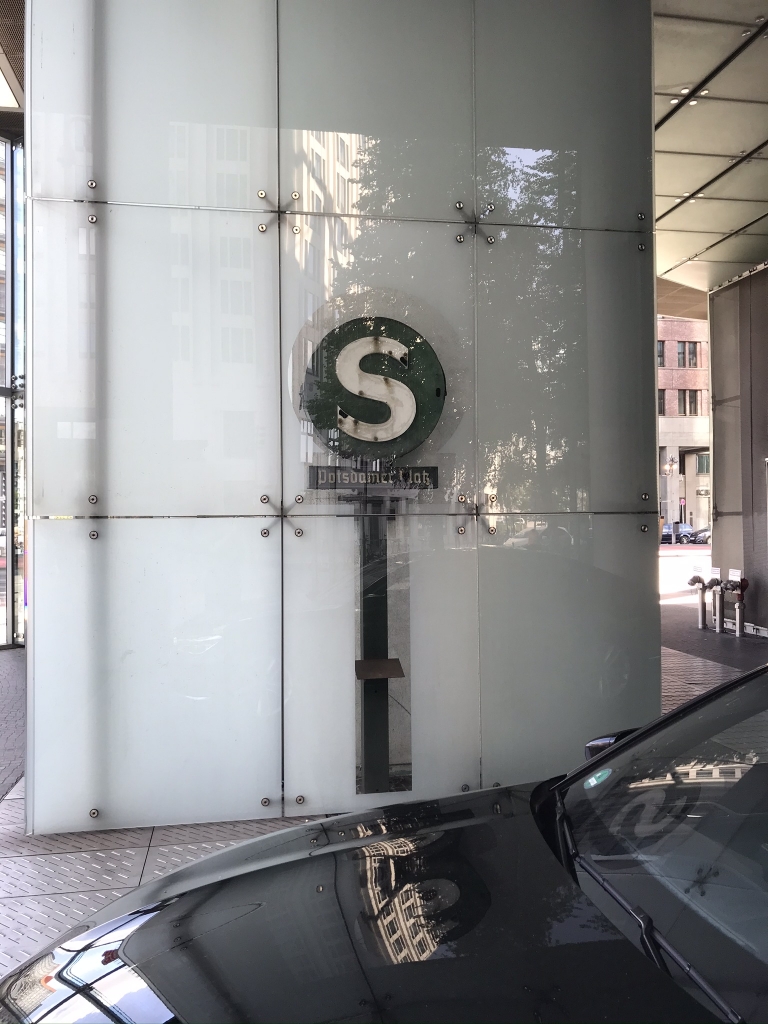
This old S-Bahn sign was put by the entrance of one of the Potsdamer Platz S-Bahn stations in 1939. It stood there for decades, through all of WWII and the Cold War. Even after the Wall was built and the station entrance boarded up, this sign still stood right next to the Wall on the west side.
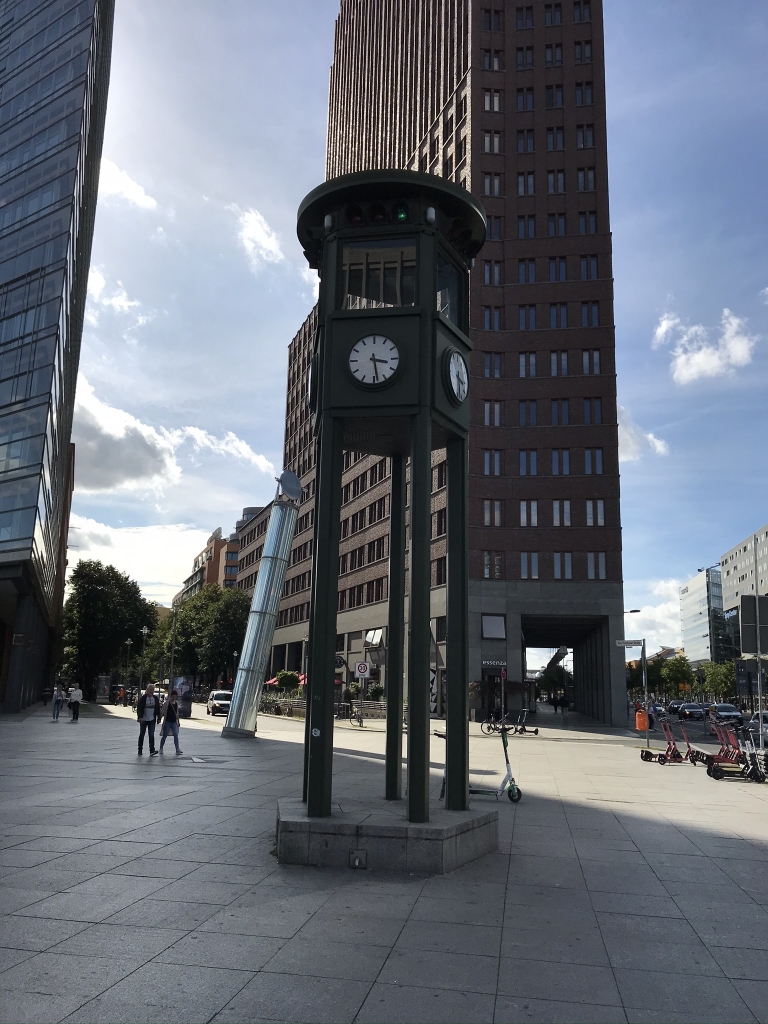
This is a replica of the traffic control tower--something that used to be common in the 1920s and '30s before traffic lights as we know them were invented--which used to stand in the center of the intersection in Potsdamer Platz.
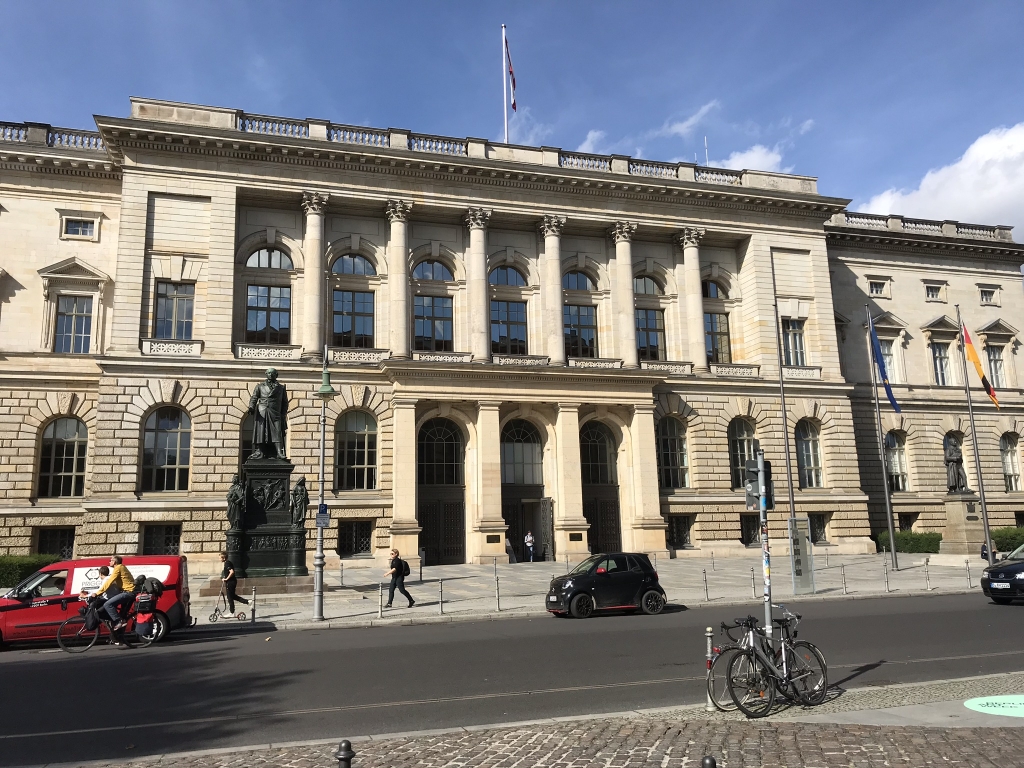
The city of Berlin is its own state, just like Hamburg, and the Landtag (State parliament) meets here in the Abgeordnethaus. Originally this building hosted the Landtag of Prussia back when Prussia was still a state, before WWII.
It was at this point I visited the Topographie des Terrors.
Eventually I found myself in the vicinity of Checkpoint Charlie, or, at least, where said checkpoint used to be. I've already written in depth on that subject and the adjacent museum. All I'll say here is that while the history within the museum was fascinating, and it was a real learning experience, it was still full of extremely wordy walls of text.
After I finally made it out of Checkpoint Charlie, I needed some dinner. I stopped at a nearby Irish pub called Murphy's. I had a pretty good turkey salad with a 50cl glass of Newcastle and an Irish Coffee.
The sun was going down, and I needed to check into my hostel: St. Christopher's Alexanderplatz. There's two ways of getting there from Potsdamer Platz, directly via the U-Bahn, or with one transfer via the S-Bahn. The U-Bahn is a lot slower, as I later learned, but this is how I got there for the first time Friday night.
Alexanderplatz was the heart of downtown East Berlin during the divided city era when the Berlin Wall cut right through the traditional city center. It was during those turbulent 1960s, when the Wall was still brand new, that the World Clock and the nearby TV Tower--now a symbol of modern Berlin--were built.
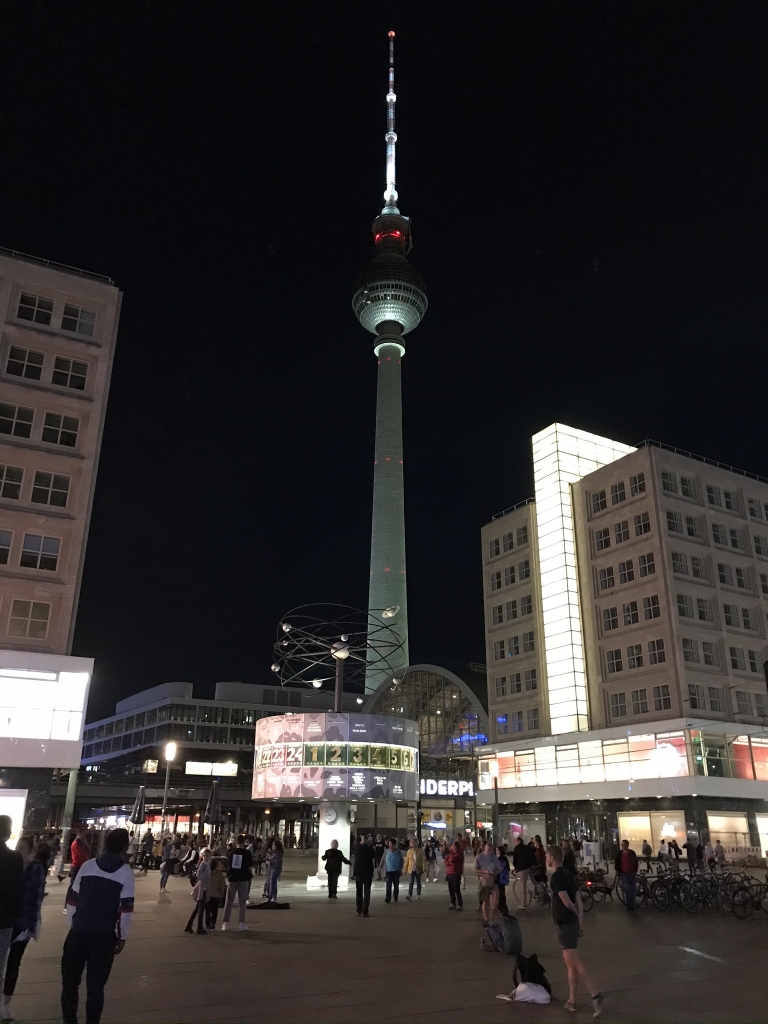
Communism did produce a few good things after all.
That World Clock looks interesting, let's take a closer look...
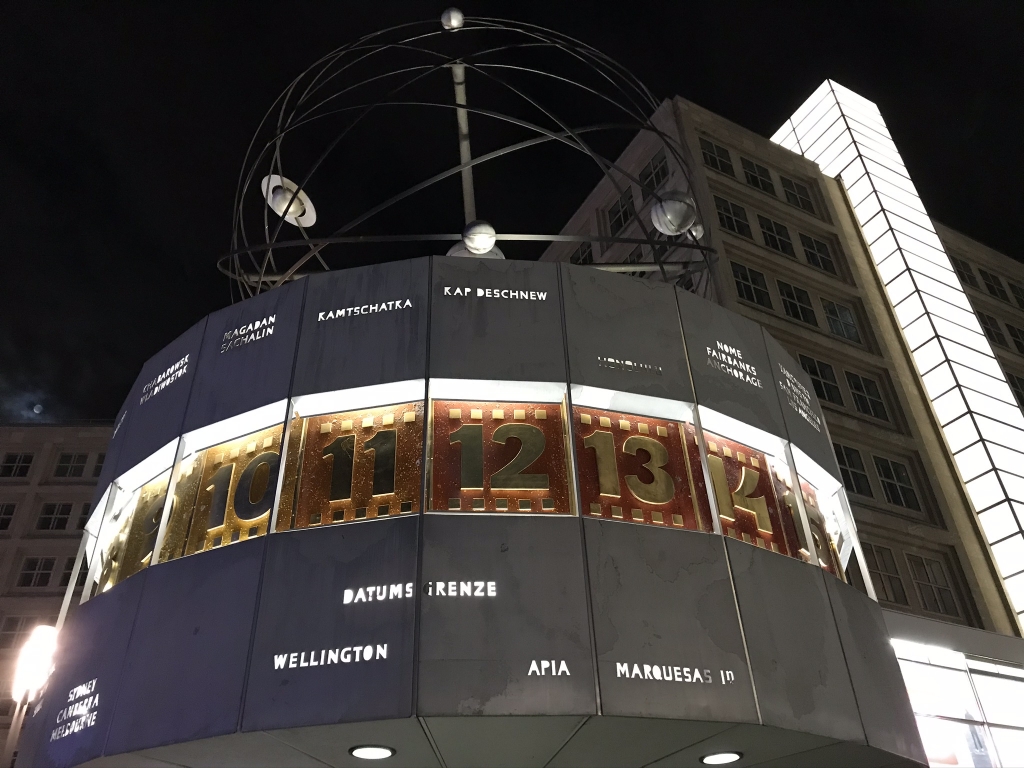
The World Clock was built in 1969. I love how retrofuturistic it looks; it's the sort of thing you'd expect to find in Tomorrowland in Disney World. The strip with the big numbers, representing hours, on it slowly rotates and tells what time it is in the cities whose names are engraved all around it.
After the tourist-trappy Potsdamer Platz, I thought Alexanderplatz felt more like a real downtown. While it was a similar collection of big stores, restaurants, and landmarks, it was clearly dominated by local people and not tourists. A whole bunch of people were congregated there, sitting around the statues and fountains, many of them drinking bottled beer, and there was a busker under the World Clock singing "Hallelujah," the Leonard Cohen song made famous by Jeff Buckley. I liked the atmosphere, but there was somewhere else I was trying to get to.
The hostel was not actually at Alexanderplatz but a short walk away on Rosa-Luxemburg-Straße across from the Volksbühne theater. It is part of a British-owned chain and everyone there speaks English by default. I went through the check-in procedure and got my room keycard, along with a padlock with which to lock the locker under the bed, so I wouldn't have to carry all my possessions around every day.
It seems every St. Christopher's location has a sports bar called Belushi's. I had to have a beer there before heading out to see what else was out there. We're still in the middle of a pandemic, though, so you can't approach the bar to order anything, you have to sit and wait at your table, and you have to be masked unless you're sitting at a table. I had 30cl of Spaten.
I probably should've stayed there because everywhere was closing up surprisingly early. Even so, I made it to two establishments where I tried some new-to-me unfamiliar beer. First, on Leipziger Platz, which is right next to Potsdamer Platz, I stopped at Elleven (spelled exactly like that) Cocktail Bar. I did not have a local beer there but one from Hamburg. In my travelogue about Hamburg, I mentioned at the end that I wasn't too impressed by the beer, but also mentioned that I probably just need to try more of it. I was on to something there, because that night at Elleven in Berlin I had a 50 cl of Duckstein Weizen and that really was a good wheat beer. So if you're ever in Hamburg, or anywhere else in Germany, Duckstein is a name to remember.
I also had a 30 cl of Berliner Pilsener. Pretty good, but nothing really stood out about it.
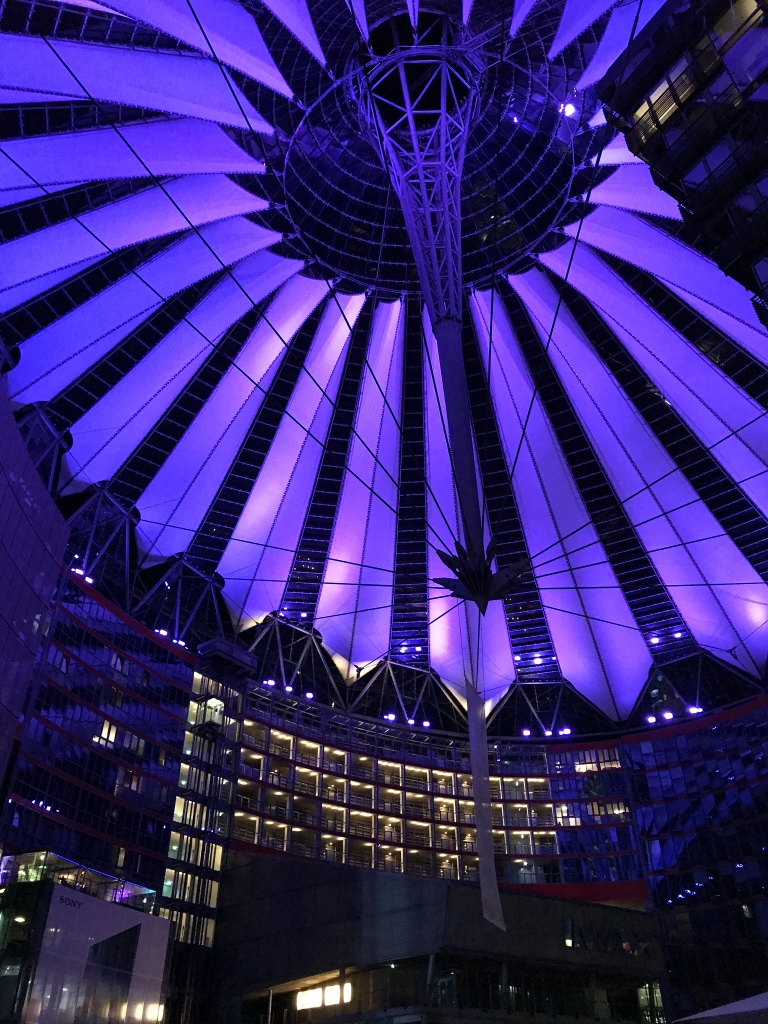
My last stop of the night was the Sony Center on Potsdamer Platz. Most tourists in the city probably don't know that the Sony Center has a bit of a heritage to live up to, occupying the former site of the Hotel Esplanade, a famous hotspot of the interwar golden years. Inside the Sony Center, well, actually it's still outdoors, because the center is really a ring of buildings around a huge open-air atrium with a pavilion-style roof far above, as you can see in the picture. Inside this ring you will find many restaurants with outdoor seating. One of them is called Lindenbräu which also seems to brew their own beer. I had 50 cl of Zwickl, and that was the tastiest beer of the night, reminding me why I like unfiltered Kellerbier/Zwickl so much.
Saturday, September 5, 2020
As awesome as St. Christopher Hostel was, there's only one thing I could complain about: the "continental breakfast." Now, I have seen ads, presumably from the pre-Corona era, mentioning a breakfast buffet. They can't do that anymore because of the pandemic, but what they replaced it with was not satisfying. It was only, I think, 2€, and it was just a paper bag containing an orange, a croissant, a granola bar, and orange juice, and you could get some coffee along with that. That was not enough for me so I had to stop at a coffee shop near Alexanderplatz.
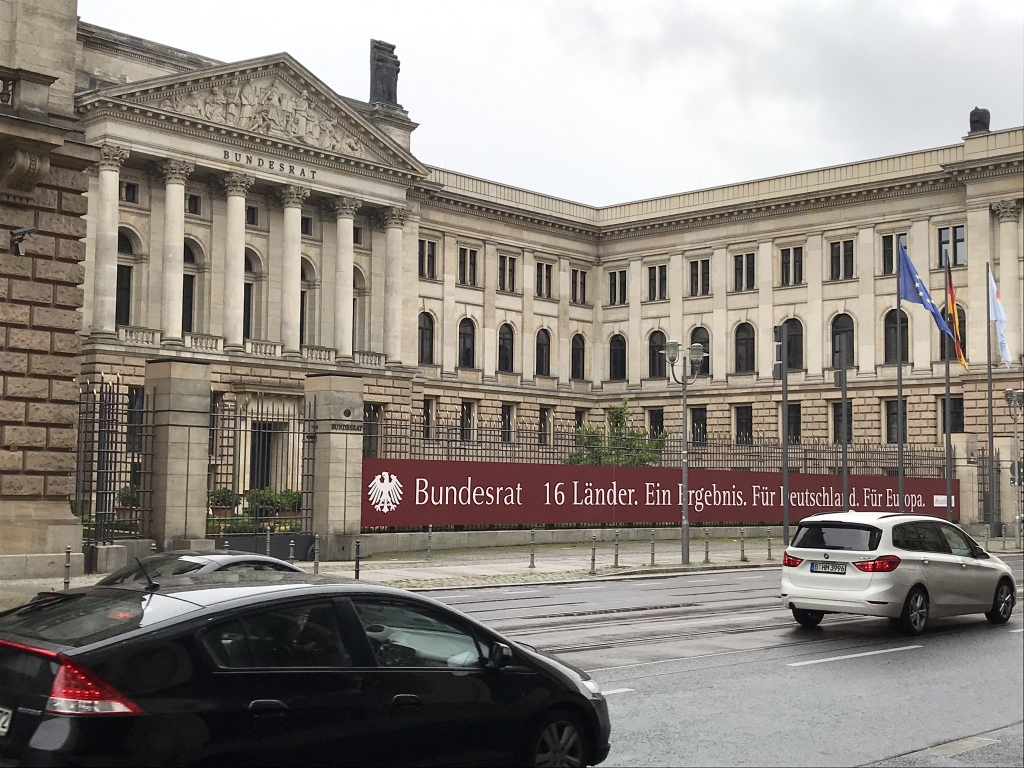
While walking around downtown Saturday morning I happened to find this building. The Bundesrat ("Federal Council") is the upper house of the German parliament, analogous to the US Senate. Previously this building was built for the Prussian House of Lords, the upper house of the Prussian parliament when that state existed (as a kingdom and later as a state within Weimar Germany). Being in the former East Berlin, the Communists used it as the East German Academy of Sciences. The Bundesrat moved in from Bonn in 2000.
Unsure of where to go next, I took the S-Bahn to Potsdamer Platz and headed west where I took some time to look at the memorials to the victims of the Holocaust.
There was one museum on Leipziger Platz I just had to check out, called the Spionagemuseum (Spy Museum). This was dedicated to all kinds of spycraft and intelligence gathering. To really set the mood, there's a huge cluster of video cameras pointed at you as you walk through the inner doors past the front desk.
This museum was an interesting learning experience but it was still mostly walls of text and artifacts behind glass. I didn't soak up quite as much information from this one as from the other Berlin museums I've blogged about. Here's a few highlights from it:
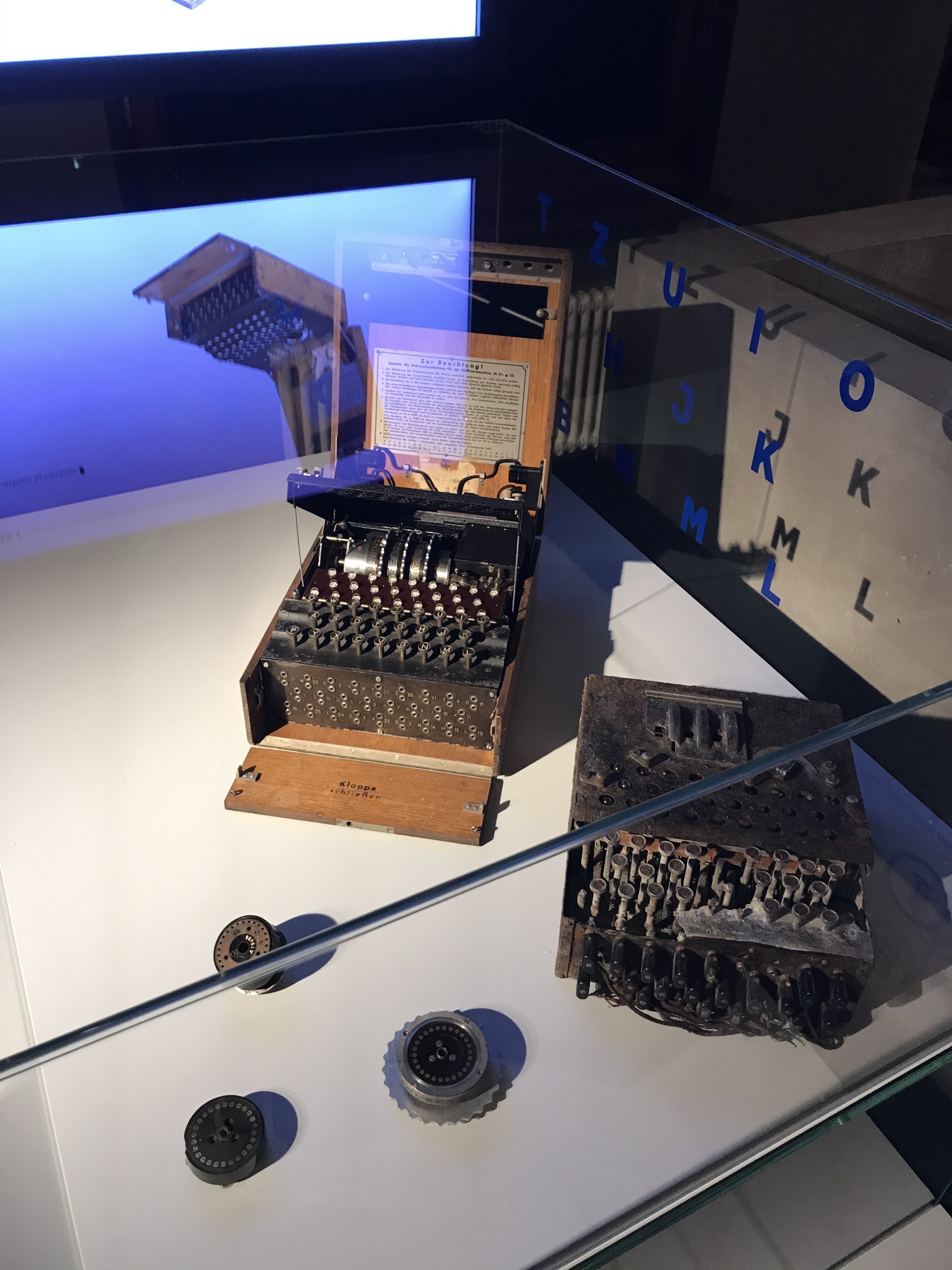
Original Enigma code machines used by the Nazis in WWII.
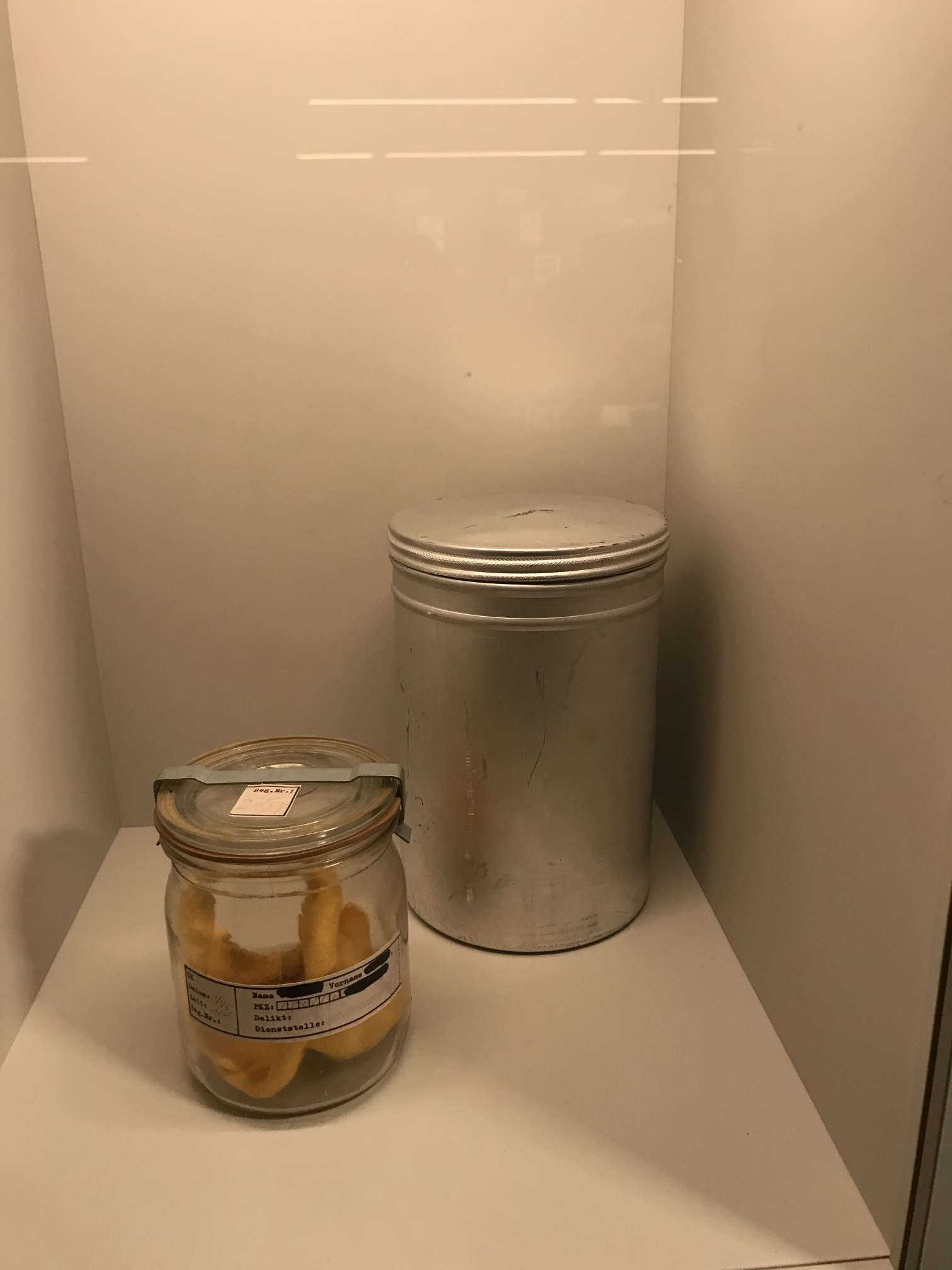
What are these, pork rinds? No, they're odor samples. Really! Apparently the East German Stasi, their secret police, used to collect these samples from the people they interrogated.
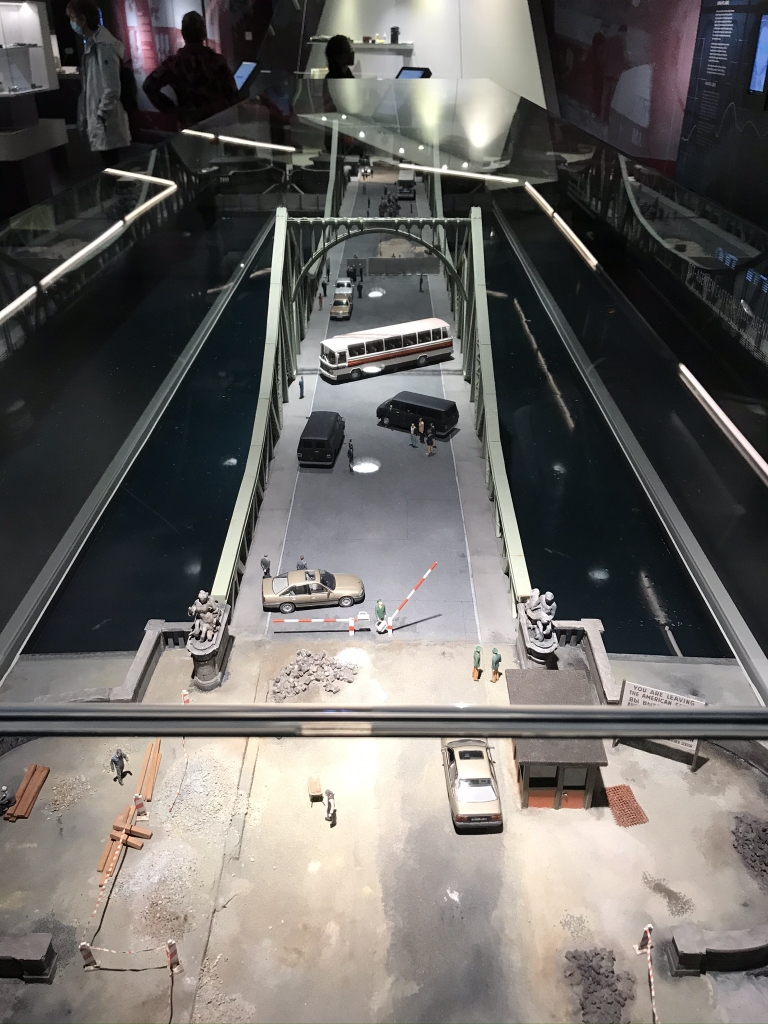
This is a depiction of the famous prisoner transfer on the "Bridge of Spies" in Berlin in 1962. This was where the Soviets handed over the captured U-2 pilot Francis Gary Powers to US forces in exchange for the captured KGB agent Rudolf Abel. This moment was reenacted in the 2015 Spielberg film Bridge of Spies.
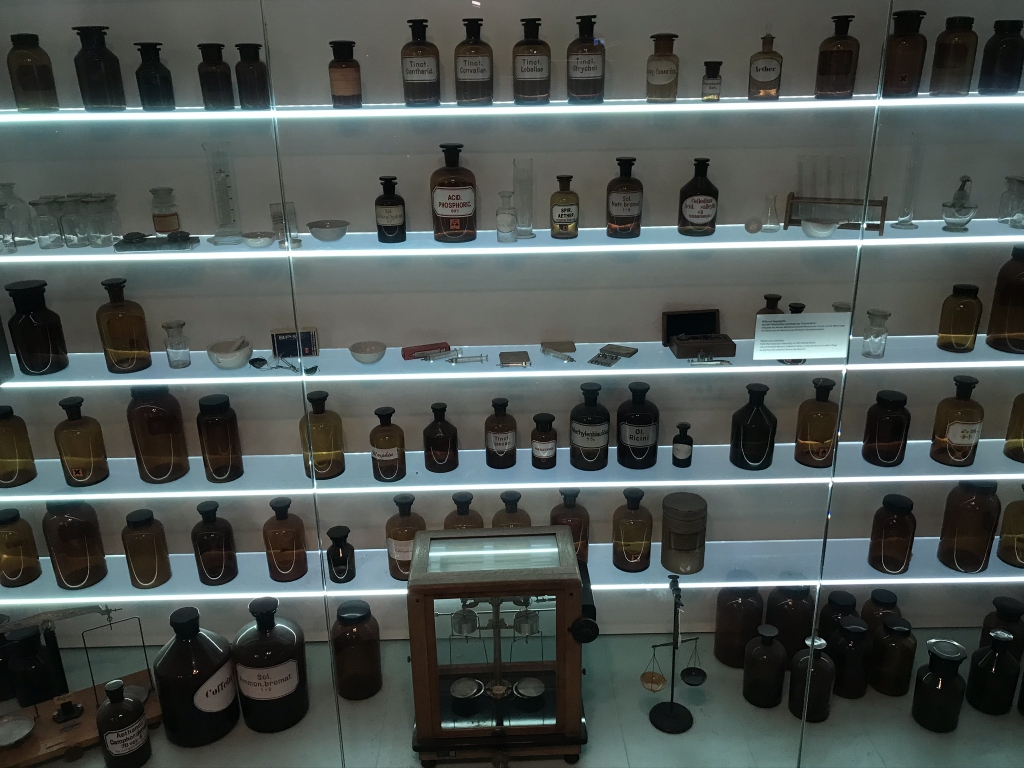
A wall full of poisons, the kind used by assassins.
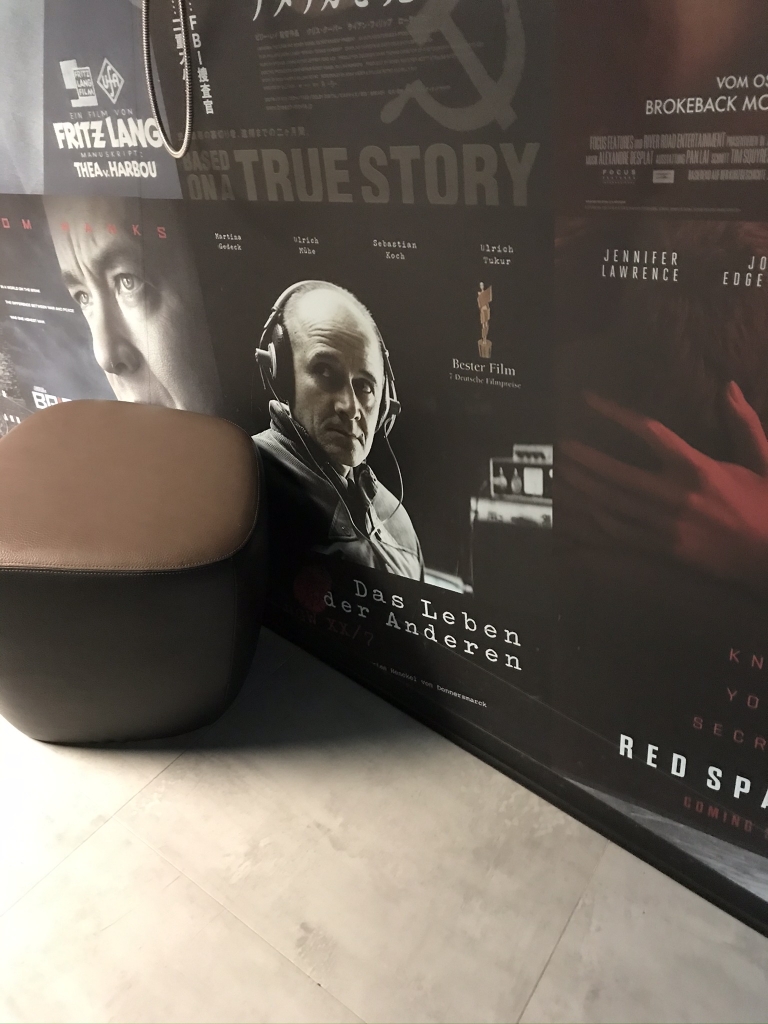
This is from the part of the museum which is all about depictions of spies in TV and film. This one wall was covered with movie posters. I had to take a picture of this one because Das Leben der Anderen ("The Lives of Others") was a film I really liked, which is about a Stasi agent spying on a playwright in early-'80s East Berlin.
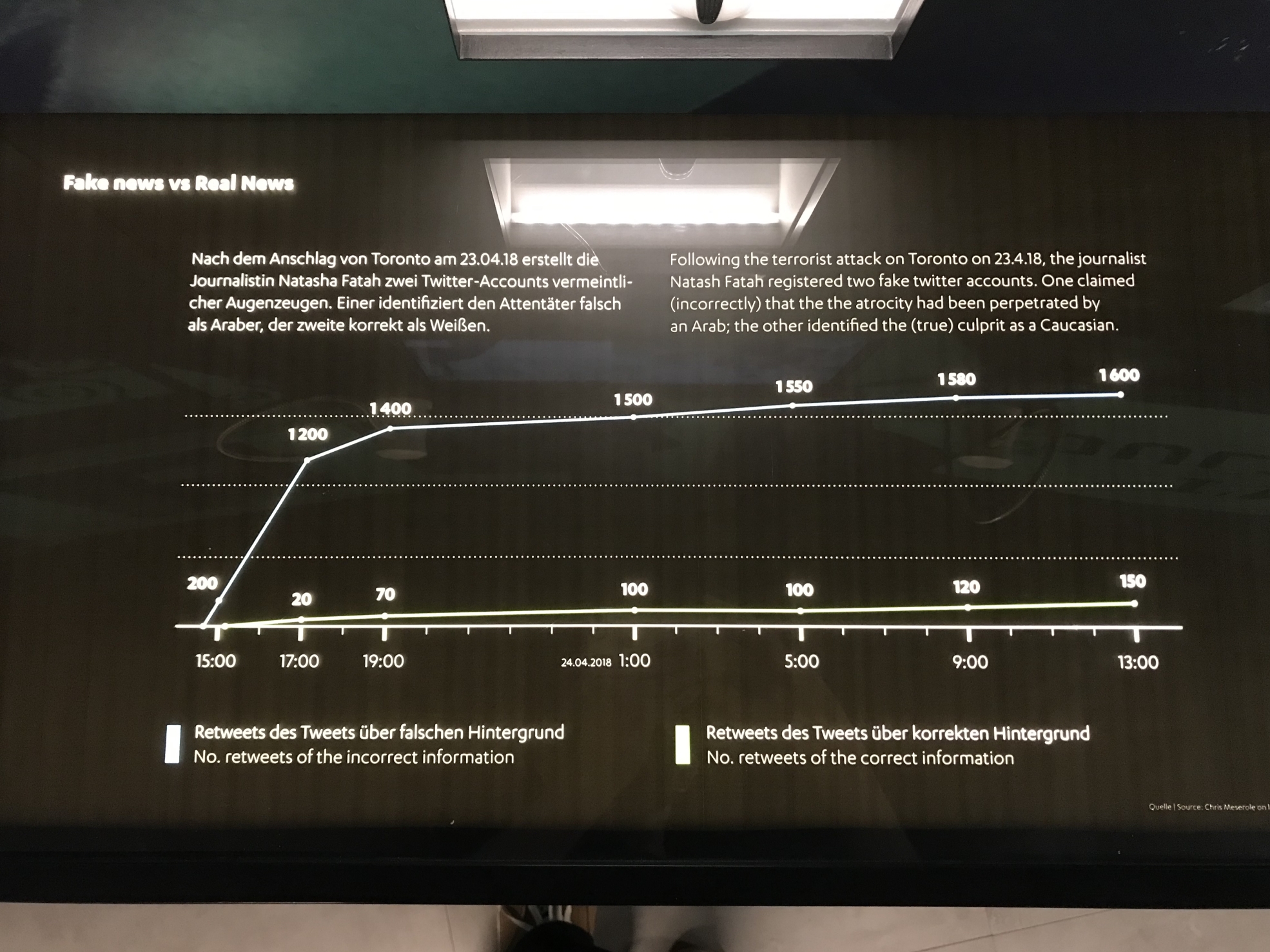
And finally, something I feel is quite important. I didn't want to bore you with all the other walls of text, but this was one that really needs to be shared. There is a lot of disinformation out there and you can't believe everything you read, especially things that are clearly written specifically to make you angry, especially if it's on Twitter.
For lunch after the Spy Museum, I walked back over to Potsdamer Platz and hit up Lindenbräu in the Sony Center again. I ate a turkey salad again; yes, the same thing I had for dinner the night before, but this still looked appetizing. I accompanied that with 50cl of Märkischer Landemann dark beer.
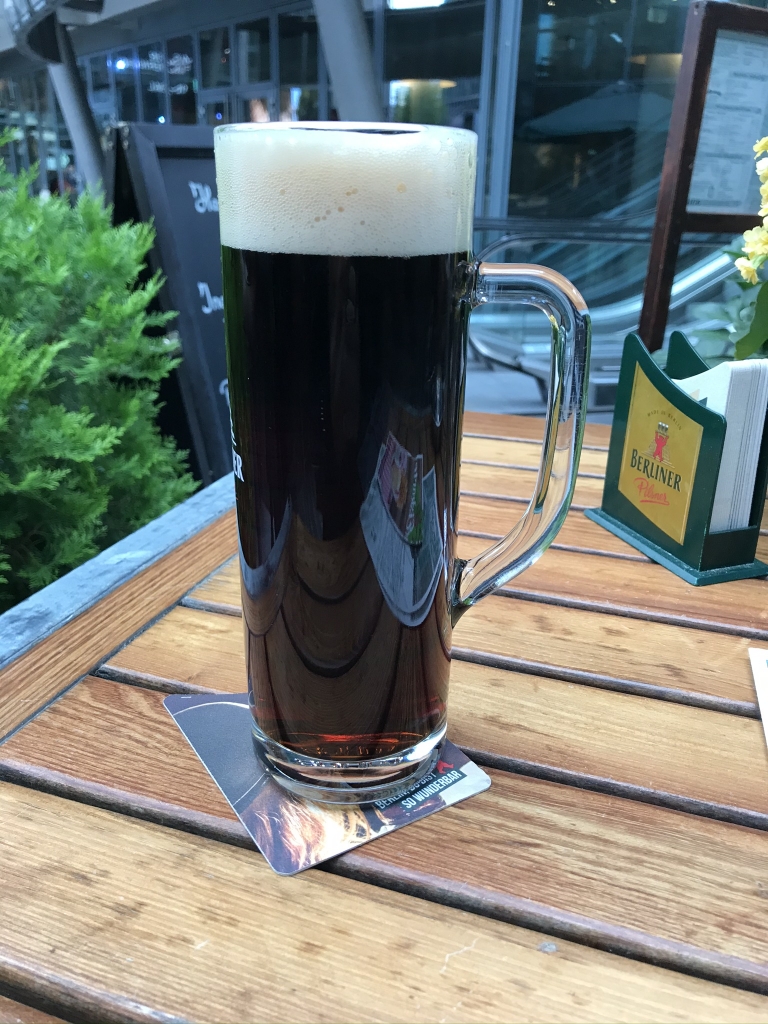
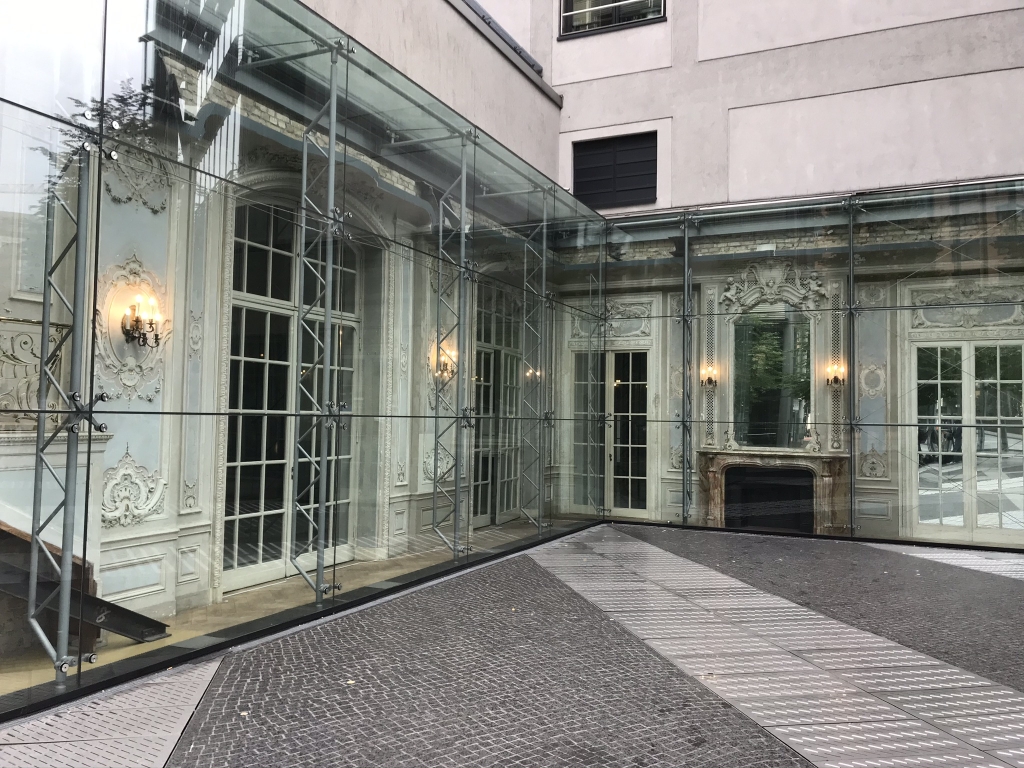
Some of the preserved remains of the famous Hotel Esplanade. What you see here used to be part of the ornate dining room called the Kaisersaal. The Kaiser himself, the emperor of Germany until the end of WWI, used to dine here. During the interwar days, when there was no more Empire or Kaiser, this is where you could find famous writers and actors sipping tea. Most of the hotel was destroyed by bombs during WWII. What is preserved here behind glass was excavated from the rubble and reconstructed decades later. There's more to be found here at the Sony Center that didn't find their way into my photos.
After lunch I rode the U-Bahn to the Allied Museum which I covered in my first blog entry about this trip. Another U-Bahn, after the museum visit, brought me to Kurfürstendamm.
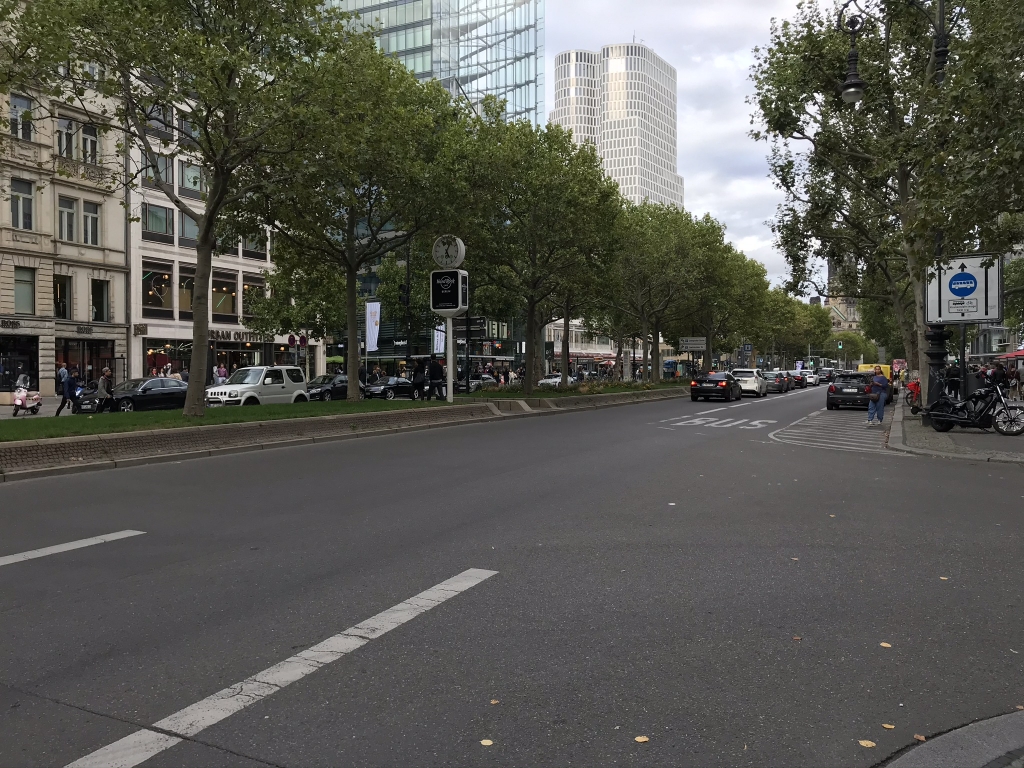
This long street, lined with countless shops, department stores, and restaurants, is known as Kurfürstendamm, or "Ku'damm" as locals call it. After the Wall went up, this was on the west side of it, and since all the traditional downtown districts were on the east side (or in the no-man's-land like Potsdamer Platz), West Berliners made this their new downtown. Today it's still a huge shopping district.
I really wasn't interested in shopping. After walking down the Ku'damm for awhile I was just going to catch an U-Bahn out, but above the stairs down into the U-Bahn station there was an advertisement for a restaurant called Mommsen Eck. It said they had over 100 beers, and I can't pass that up!
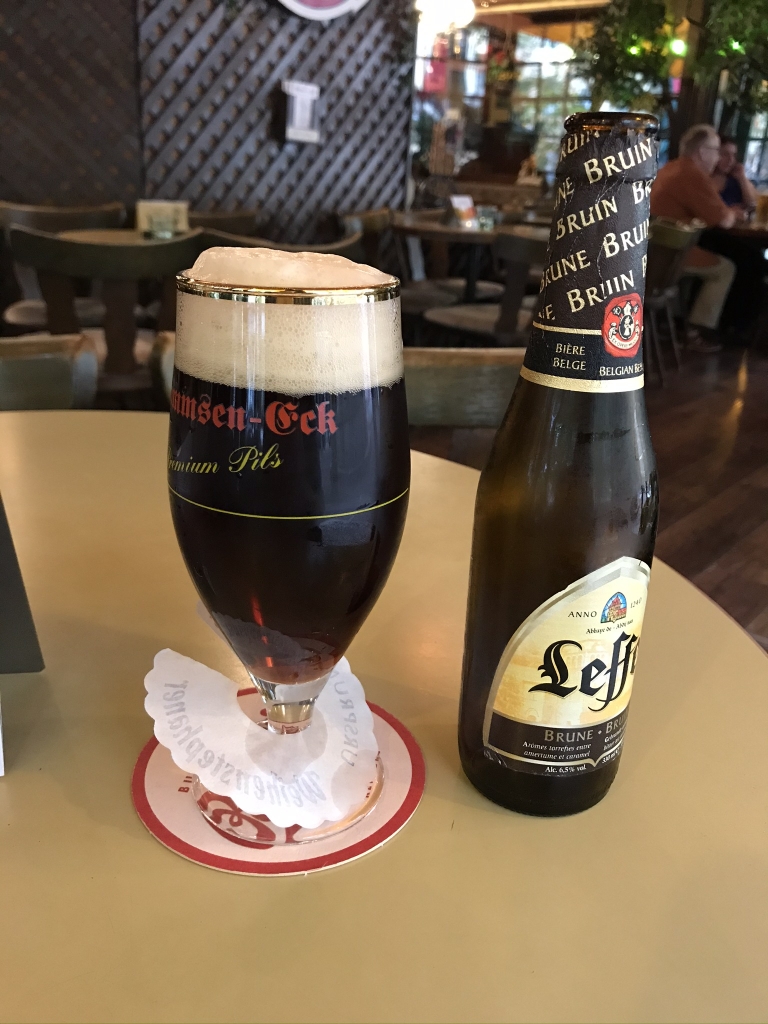
Well, out of those over 100 beers, I only had one, just to save room for later bar hopping. But it was a good one, 30cl of one of my favorite Belgian abbey ales: Leffe Bruin. If you're a beer snob like me, and you happen to be on the Ku'damm, you must go to Mommsen Eck.
For dinner I had yet another turkey salad. I wanted to branch out a bit but this one had pineapple on it!
I still wasn't sure yet what I wanted to do Saturday night. I knew Berlin had a famous electronic music scene but I also knew that the pandemic had put a huge damper on that just like it had on everything else. I'd long wanted to experience the craziness of Berghain but their operations were predictably scaled back. There were a few places still open, but did I really want to give any a try?
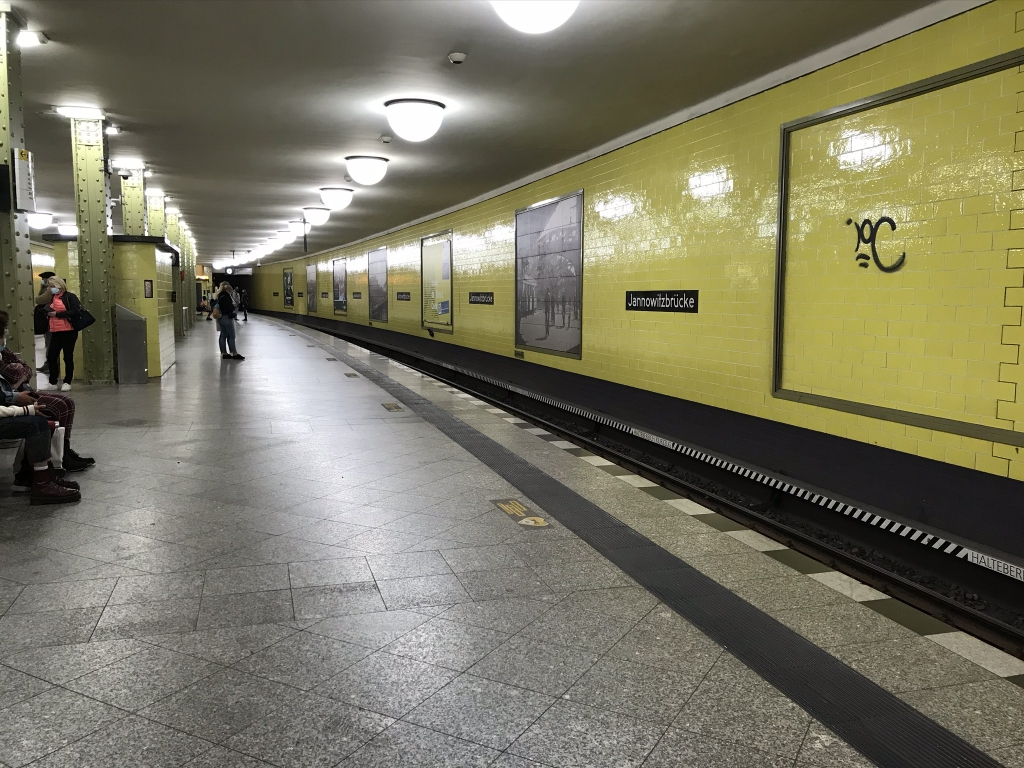
I had to transfer between different trains here at Jannowitzbrücke. Looks like a totally ordinary subway station, doesn't it? I stepped off U8 which had just been on that track. But when the wall was up, one couldn’t do that, because this was one of the ghost stations we discussed earlier. U8‘s route began and ended in West Berlin but made a few stops in the East, so when the wall went up this and other such stations were locked up. If I had ridden U8 31 years ago, it would have slowly moved through here, and I would’ve glimpsed this station, dusty and dimly lit, with only a couple bored border guards standing on the platform.
While wasting time walking around the Kreuzberg area I stumbled onto the East Side Gallery.
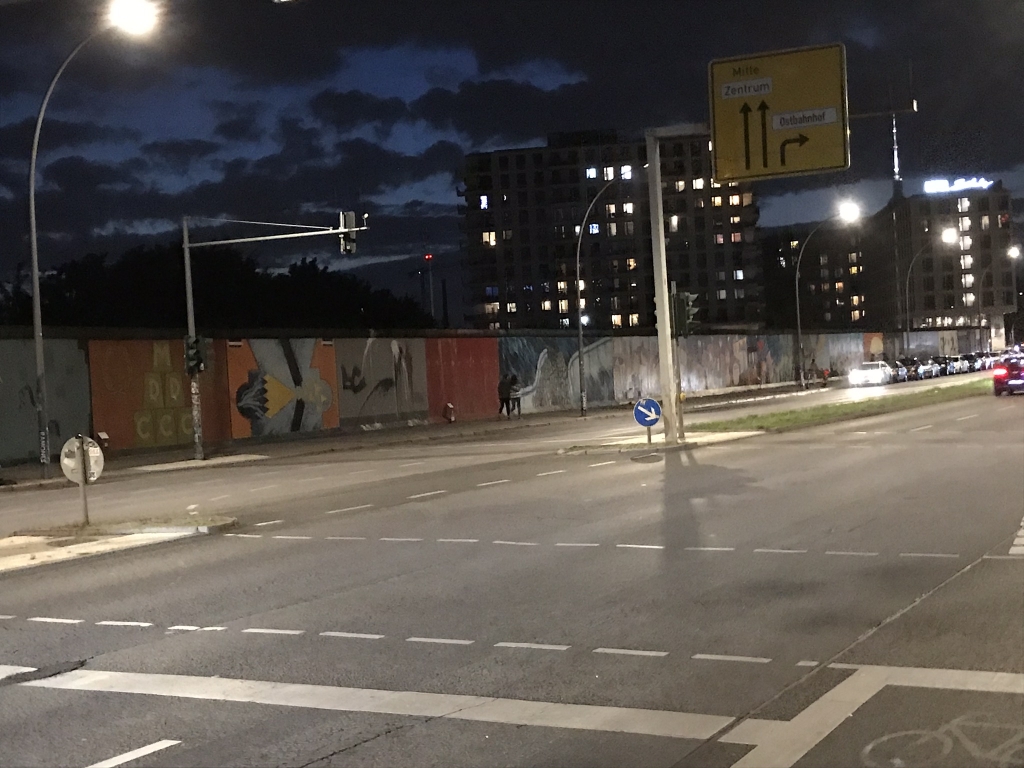
This is another long stretch of the Berlin Wall that still stands, and is famous for its murals. These murals are all relatively recent, though; this is all on the east side of the wall, thus in what used to be the death strip, and so anything you see painted here could not have been painted before 1990.
While trying to find a techno club that might still be open, I took an S-Bahn to the Treptower Park station. As the train pulled into the station, I saw what looked like a Biergarten very close by. I walked toward this place from there and I could hear some great music pulsating from within! When I got there--it was called Else--they wouldn't let me in, because they were only letting in people who had bought a ticket online. Considering the pandemic, that's understandable.
I can't remember the name of the club I was trying to find. I lost interest before I made it there. I had been walking around all day, and I checked my iPhone's health app and found I'd racked up over 32,000 steps up to that point that day! My feet were aching and the only nightlife I really wanted was to sip some beer at an upscale bar. So I took the S-Bahn one station north to Ostkreuz station, in the Victoriastadt neighborhood, next to Friedrichshain, to see what I could find in that respect.
The first place I visited was called ML. It was OK, but it didn't keep me there for longer than one drink. The beer was all bottled, and I had a 50cl bottle of Köstritzer. I'd had this same beer before, in Konstanz, and it's good, I just would've preferred to drink it out of a glass.
The next, and last, place I stopped that night was the most memorable. It was called BBB. This is a burger restaurant, but they had a pretty good bar too. Interestingly, the music played in the background was all from the '50s: The Platters, Buddy Holly, and the like. First, I had a 50cl of their Kellerbier that was on tap. I think it's one they make themselves. It was delicious, just as any Kellerbier is to me.
In case you didn't read my deep dive into the brewing process which I learned at the Stiegl brewery, Kellerbier, also called Zwickl, is unfiltered beer. After the beer is more or less finished brewing, the brewers usually filter out all the yeasts, proteins, and other such leftover materials in it which have already done their work in the brew. Unfiltered beer, which looks cloudy due to all the stuff in it which was not filtered out, still tastes pretty good, which is why many breweries sell it as its own style. It's really become one of my favorite kinds of beer in the last couple years.
I also had a glass of a red La Rioja wine, since I wanted to branch out a bit from just beer, and then went back to beer with a 50cl of Krombacher Weizen. BBB was a nice place and I'd have to recommend it to anyone who happens to be in or around Friedrichshain. I wouldn't know how good their food is but the drinks were great.
Sunday, September 6, 2020
The first half of this day was taken up by my visit to Potsdam, and most of the afternoon was spent at the Wall Remembrance Walk.
At the end of the Wall remembrance walk, between its northeast end and the Mauerpark, I found a large flea market where vendors were selling all kinds of old goods. I spent I don't know how much time looking through boxes of old vinyl records, but the market closed down for the evening before I could decide on something to buy.
It turns out that wasn't the only flea market going on in that part of the city. Mauerpark hosts a huge, bustling flea market every Sunday, as well as a couple outdoor restaurant/bars. At one of these restaurants, Mauersegler I believe, I got my dinner, some kind of salad (of course) and a jar of peanuts I got with it. I only had half the peanuts because there were quite a lot. They had some pretty good beer there too: first, a tall 50cl glass of Traunstein Weiße, a wheat beer, and then 30cl of Mauersegler Pils. I liked the first one, the wheat beer, enough that I kept the glass.
Yes, you can keep the glass the beer is served in at certain establishments; if you have to pay an additional Pfand along with the cost of the beer--say, for example, the price of a beer is 3€ but you have to pay 5€--when you finish it you can either return the glass to the bar and get your extra 2€ back, or just keep the glass for yourself. This time I kept the glass for myself.
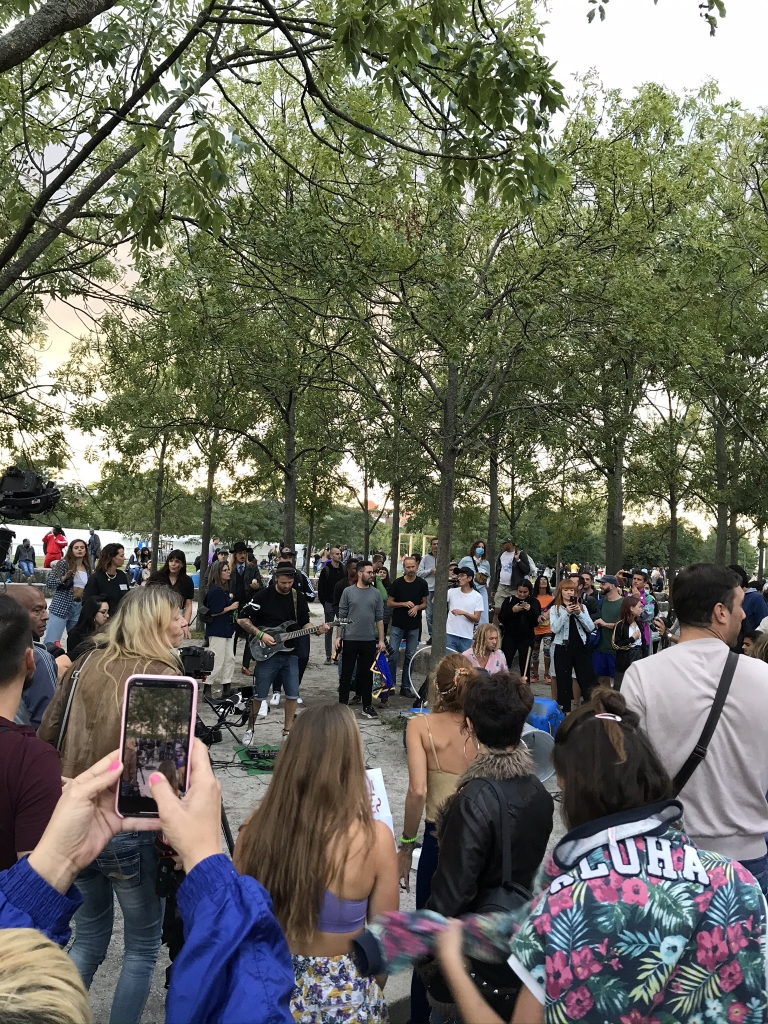
A band from the UK playing in Mauerpark.
Monday, September 7, 2020
It was on Monday morning that I visited the DDR Museum, my favorite museum of the whole trip.
After the DDR Museum I got lunch from a corner store, a Brötchen with a slab of breaded chicken in it. Then I had to make a tough choice. I had been putting off visiting the Fernsehturm and really wanted to go up in there...but I only had an hour left before my train took off and I needed to do some grocery shopping before that. I waited in line for a little bit, but thanks to that damn pandemic they were limiting how many people could be up in the observation deck at one time. Thus I had to pass up this opportunity, bought the groceries I needed at the Rewe in the central train station, and boarded my train with a few minutes to spare. I may not have had to rush to meet the train, but there certainly wasn't enough time to fit a visit to the top of the tower in there.
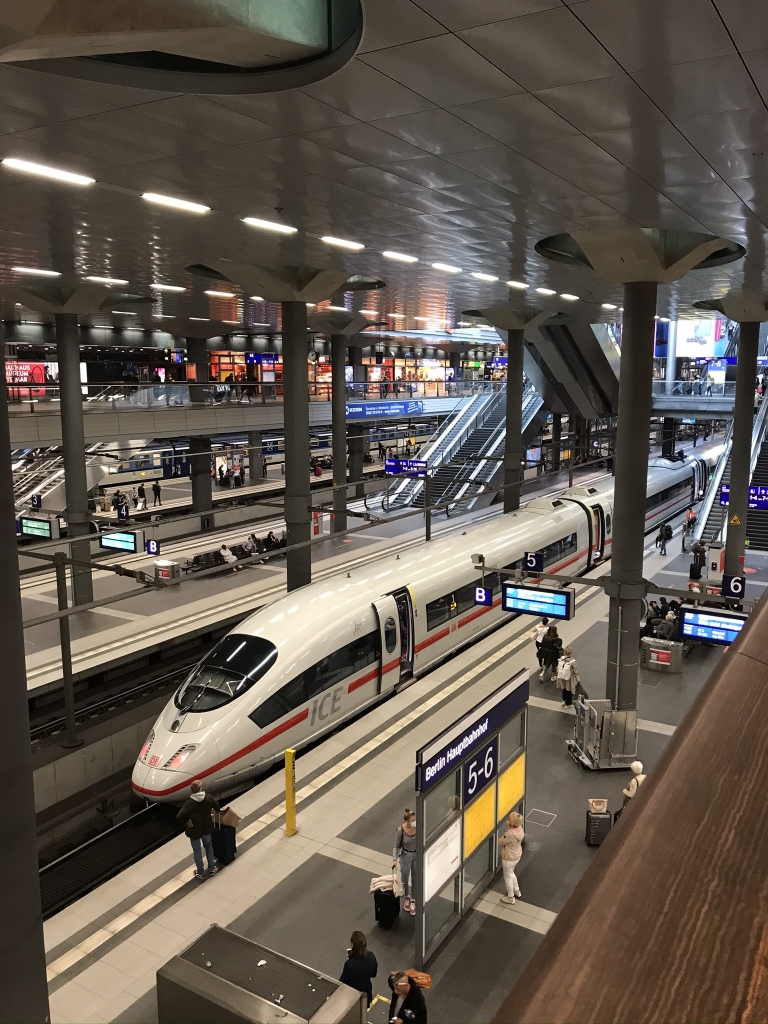
Inside Berlin's main train station, the most modern and probably the biggest such station I've been to in Germany.
I could end it there, but I have to add what I had for dinner on the way back: marinated cauliflower and broccoli with beets and mixed grains. Typing this now, here in my new home in sparsely populated eastern New Mexico, I know sometime later this year or next, on another epic trip, I'll be probably be eating a bland salad on an Amtrak train while thinking "Man, I really miss Deutsche Bahn."

